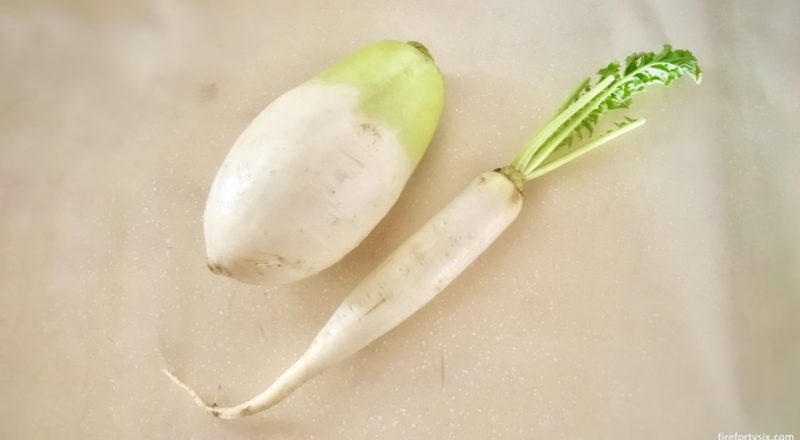Chai tow (菜头) means radish in the Hokkien dialect and it’s a common ingredient used in many Chinese dishes such as fried carrot cake (which, despite its name, uses radish instead of carrot), radish soup and braised beef with radish. The green radish tops are also edible and, when roughly chopped, impart a pleasantly bitter taste to a simple fried rice.
The Wife usually gets her radishes from Zenxin Organic, either physically from Cold Storage supermarkets or online from their official store on Shopee. It’s more expensive than what’s available from our wet market downstairs, but it’s certified organic, sweeter and always come with their tops intact.
Recently though, we’ve been binge watching “Delicious Rendezvous” on Viu, hosted by the famous Korean chef Baek Jong-won, and have been quite impressed by the super fat and juicy Korean radishes that have been featured in several episodes. So when she saw them in the produce section of her regular Korean mart, she immediately bought one home to try.

Since she also had one Chinese radish left in the fridge, she decided to hold a head-to-head competition between the two types of radishes, to see which one tasted better.
And the best way to compare them would be to make the simplest dish possible — pickled radish, which also happens to be the perfect accompaniment to fried chicken. In order not to give either one an unfair home ground advantage, she chose two recipes: one Chinese, and the other Korean.
For the Chinese recipe, she went with the 醃黃蘿蔔 by popular Taiwanese food blogger Carol 自在生活. Here’s the (adapted) recipe:
- Marinade: Add sugar, vinegar, water and 3 pieces of yellow gardenia fruits to a pot, bring to a boil. Set aside and let cool.
- Add 1 teaspoon salt to cut radish and mix well; cover and press down with heavy object like canned beans for 1-2 hours.
- Pour away the liquid from cut radish. Rinse radish with drinking water if lower salt intake preferred. Drain well.
- Combine radish and marinade.
- Store in an airtight glass container and keep in fridge.
- Start enjoying in 2 days!

For the Korean recipe, there was only really one choice, the undisputed queen of Korean home cooking — Maangchi! and her 치킨무. Here’s the (adapted) recipe:
- Add sugar, vinegar, water and pinch of salt into a bowl.
- Stir to combine (till salt and sugar dissolve).
- Add cut radish and mix well.
- Store in an airtight glass container and keep in fridge.
- Start enjoying in 2 days!

The taste test was held over a dinner of (what else?) fried chicken. And again, to be fair, it wasn’t KFC (“K” for Korean, not Kentucky) but American-style fried chicken from Popeye’s.
So, who won?
It was close.
The Wife preferred Carol’s recipe while I preferred Maangchi’s, but we both felt that the Korean radish won in both recipes. The Chinese 白萝卜 was good, but the Korean 무 was just that little bit crunchier and that little bit juicier. Its taste and texture was quite close to Chinese pear, interestingly enough, and was very refreshing as a pickle and palate cleanser.


The Korean 무 is not commonly available in Singapore, but I’m guessing that The Wife is going to buy one back whenever it’s available. One challenge though, is that each piece is quite chunky and will take the two of us some time to finish. They say that good things come in small packages, but in the case of radishes, it’s clearly the other way round.
Note: This post contains affiliate links. If you use these links to buy something, I may earn a commission. Thanks.
